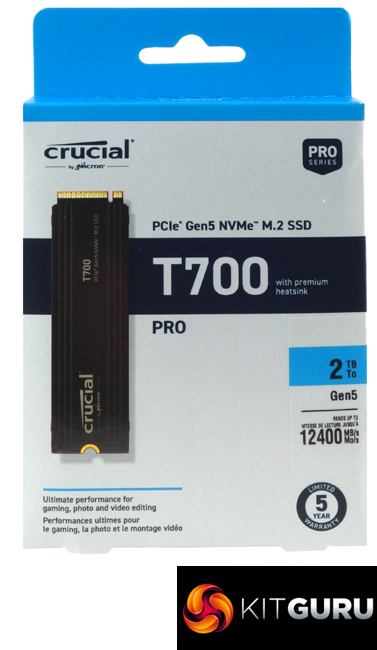Launched at the same time as the standard T700 which we looked at HERE, Crucial's T700 Heatsink version comes as the name suggests, with a factory-fitted heatsink. Crucial has aimed the T700 at the professional, gamer and enthusiast market segments. The drive is rated as up to 12,400MB/s and 11,800MB/s for Sequential reads and writes respectively. The passive heatsink Crucial has used for the T700 isn't as massive as some we have seen and it does work quite well, bearing in mind how hot these first generation of Gen 5 drives run at when they are being pushed.
At the heart of the drive is a Phison PS5026-E26 controller. Built on a 12nm process, Phison's 8-channel E-26 is the world's first consumer Gen 5 controller. It uses dual Arm Cortex-R5 cores that work together with Phison’s own CoXProcessor 2.0 specialized accelerators supporting data transfer speeds of up to 2400 MT/s (it's running at 2000MT/s in the T700) supporting up to 32TB of TLC or QLC NAND flash memory. The controller also supports Phison's 5th Generation LDPC ECC engine. The T700 makes use of Micron 232-layer (B58R) 3D TLC NAND.
As with the standard T700, Crucial's T700 Heatsink model lineup comprises three capacities; 1TB, 2TB and 4TB with Sequential read/write ratings of up to 12,400MB/s and 11,800MB/s respectively for the 2TB and 4TB drives and up to 11,700MB/s for reads and up to 9,500MB/s for writes with the 1TB model. Random 4K performance is rated as up to 1,500,000 IOPS for both reads and writes with the 2TB and 4TB models and up to 1,350,000 IOPS for reads and up to 1,400,000 IOPS for writes for the 1TB drive.
Using the ATTO benchmark we couldn't quite get to the maximum Sequential figures with test results of 11,119MB/s for reads (which was a tiny bit more than the standard drive) and 11,003MB/s for writes. We could however confirm the official figures with the CrystalDiskMark 8 benchmark, with a read test result of 12,405MB/s with writes coming in at 11,826MB/s.
As for random performance, using our four threaded tests we could get nowhere near the official 1,500,000 IOPS for read and writes with test results of 512,296 IOPS and 486,257 IOPS respectively. Once again it was the CrystalDiskMark 8 benchmark that confirmed the official ratings. Using the Peak Performance profile we saw a best test result of 1,567,364 IOPS for reads and 1,653,508 IOPS for writes.
The one thing to remember about these first-generation Gen5 drives is that they need some form of cooling as they run hot. If you don't have any form of motherboard cooling then the Heatsink version of the T700 is a good choice especially as its heatsink is one of the more compact we've seen. As an example of why these drives need cooling of some description, we ran ATTO on a bare, cooler-less T700. The drive has been designed to start throttling back if it goes above 81° C and will thermally shut down at 90° C. Within a couple of minutes the drive hit 81° C and started to throttle back with reads dropping from 9GB/s to 5.9GB/s and writes falling further, from 11GB/s to 6.3GB/s.
We found the 2TB Crucial T700 with Heatsink on Crucial's website for £349 (inc VAT) HERE.
Pros
- Extremely fast Sequential performance.
- PCIe 5.0 interface.
- Heatsink design.
Cons
- Needs a PCIe 5.0 M.2 slot to get the best out of it.
- Pricey.
KitGuru says: Crucial's T700 drive is the fastest consumer SSD we've seen to date and the Heatsink version is handy for those without any form of motherboard cooling but you do have to shell out almost 30 quid extra for the privilege, over the standard model.
 KitGuru KitGuru.net – Tech News | Hardware News | Hardware Reviews | IOS | Mobile | Gaming | Graphics Cards
KitGuru KitGuru.net – Tech News | Hardware News | Hardware Reviews | IOS | Mobile | Gaming | Graphics Cards




